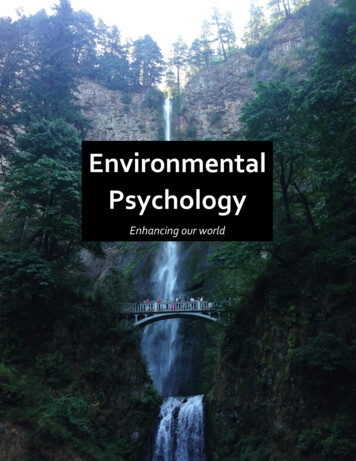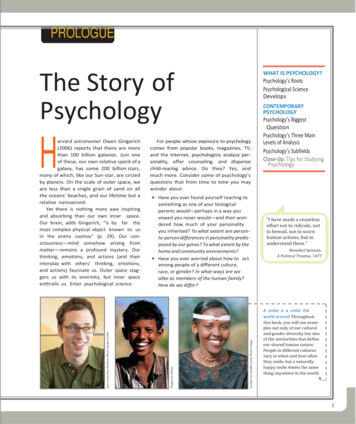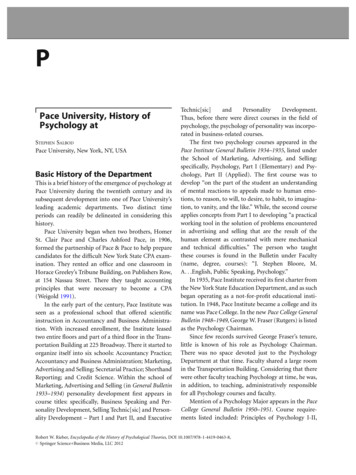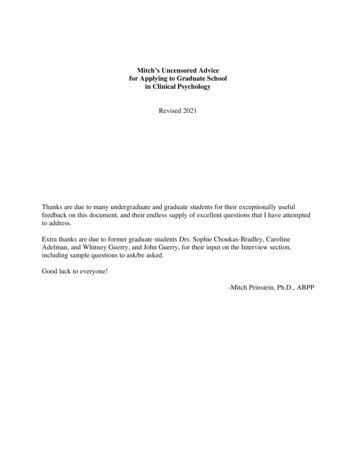
Transcription
1EnvironmentalPsychologyEnhancing our world
2ContentsIntroduction . 3Making a Difference . 5Organizations. 7Programs . 8Key Environmental Psychologists . 10References . 14
3IntroductionEnvironmental psychology is thestudy of how we, as individuals andas part of groups, interact with ourphysical settings—how weexperience and change theenvironment, and how our behaviorand experiences are changed by theenvironment. In environmentalpsychology, “environment” includesboth natural and built settings, thatis, natural resources, parks, homes,workplaces, public spaces, from thepersonal scale to the room, building,neighborhood, urban, wilderness, andglobal scales.Environmental psychology (EP) is arelatively new field—about 50 yearsold now--that has grown rapidly inresponse to the declining health ofthe natural environment and theneed to design buildings that betterreflect the needs of their users. Oneof its primary goals is to understandindividuals’ transactions with theirenvironments, and to use thisknowledge to influence policies thathelp promote sustainable behaviorand create more liveable and greenbuilt environments.buildings serve the needs of theirusers?” Answers to questions likethese have already had a significantimpact on environmental behavior,and are described later.The field is psychological in that itfocuses on the thoughts, attitudes,and behaviors of individuals and smallgroups in relation to theirenvironment. Among other things,environmental psychologists examinehow our transactions with our workenvironment are related to oursatisfaction and productivity, how ourtransactions with our homeenvironments are connected to ourwell-being, and how naturalenvironments promote mentalhealth.A BIT OF HISTORYEnvironmental psychologists ask suchimportant questions such as, “Whatprevents people from behaving in asustainable manner?” and “What canwe do to encourage environmentallyfriendly behavior?” and “How canTopics Ecological consequences of human actionsSustainability and climate changePsychological aspects of resource managementPsychological and behavioral aspects of people and naturePlace attachment and place identityEnvironmental risks and hazards: perception, behavior, andmanagementPersonal and group-based perceptions and evaluations of buildings,and natural landscapesDesign and evaluation of workplaces, schools, homes, publicbuildings, and public spacesCognitive mapping, spatial cognition, and wayfindingLeisure and tourism behavior in relation to their physical settingsStress related to physical settingsSocial space: crowding, privacy, territoriality, personal spaceAlthough EP is a relatively newbranch of science—only recognizedas a field since the late 1960s—someof its ideas have been part ofpsychological research almost sincepsychology’s inception. Its modernroots can be traced back to themiddle of the 20th century, with theideas of researchers such as EgonBrunswik (1903-1955) and Kurt Lewin(1890-1947). Brunswik argued thatpsychologists should focus on anorganism’s environment just as muchas the organism itself. Like Brunswik,Lewin viewed the environment asessential for determining behavior.He also emphasized that researchshould be driven by real-world socialproblems, and should strive to solvethese problems. His work inspiredothers such as Roger Barker, UrieBronfenbrenner, and Robert Sommer,some pioneers of EP.The late 1940s and 1950s experiencedan increase in research onpsychological processes and theirrelation with physical surroundings.These earlier studies focused largelyon human interaction with the builtenvironment, and were categorizedas research in “architecturalpsychology.” The primary goal ofmany of these studies was to improvehuman well-being and satisfaction bydesigning or altering builtenvironments.The 1960s was a time of increasedsocietal awareness, when peoplestarted becoming more concerned
4with the health of the natural world.This time period witnessed rapidgrowth in EP. Researchers began tostudy environmental issues, such ashow human activity negativelyinfluences the biophysicalenvironment, and how humancaused problems (such as noise andpollution) affect human health andwell-being. Topics such as these soonbecame an essential part of whatenvironmental psychologists did.HALLMARKS Seek to improve ourstewardship of naturalresources and the builtenvironmentDuring the 1960s, the first EPconference, journal, and PhDprogram were established, as well asthe largest environment-behaviororganization, the EnvironmentalDesign Research Association (EDRA).Today, most large national andinternational psychologyorganizations have a section ordivision devoted to EP. Study everyday settings Recognize thatindividuals actively copewith, and shape,environments—they donot passively respond toenvironmental forces Work in conjunction withother disciplinesEP encompasses an evergrowing variety of topics.Today, the field ischaracterized by a number ofkey goals and values.Environmental psychologists:JournalsThe Journal of Environmental Psychology andEnvironment and Behavior are international,peer-reviewed academic journals with strongimpact factors that focus on environmentalpsychology.Some Key PublicationsClayton, S. D. (Ed.) (2012). The Oxfordhandbook of environmental andconservation psychology. New York:Oxford University Press.Fleury-Bahi, G., Pol, E., & Navarro, O. (Eds.).(2017). Handbook of environmentalpsychology and quality of life research.Springer International Publishing.Gifford, R. (2014). Environmental psychology:Principles and practice. (5th ed.)Colville WA: Optimal Books.Gifford, R. (2014). Environmental PsychologyMatters. Annual Review of Psychology,65, 541–579.Steg, L., Van den Berg, A. E., & de Groot , J. I.M. (Eds.) (2012). Environmentalpsychology: An introduction. NewYork: Wiley.
5Making a DifferenceEnvironmental psychologists help toimprove the world in a variety ofways. Sometimes this impact isdramatic. Environmentalpsychologists have helped toinfluence the shape of cities, reducecrime, and even save lives. Othertimes, they influence the world inmore subtle ways, such as by makinghospitals more navigable, or makingnational parks more pleasant. Next,we celebrate a few of the ways thatEP changes the world for the better.PROMOTINGSUSTAINABILITYOne of the most importantchallenges that EP is helping toovercome is to apply psychologicalknowledge to help preserve thenatural environment. Many threats toenvironmental sustainability arecaused by human behavior, and sotargeting human behavior isparamount for protecting nature andnatural resources.Among other activities,environmental psychologists identifybehaviors that can and should bechanged to improve environmentalquality, determine which factorsaffect these behaviors, and developand evaluate interventions to changethem.Most people have some concern forthe environment, and this concernstems in part from egoistic, altruistic,and biospheric environmental values(e.g., Schultz, 2001). Knowing whatindividuals value helps environmentalpsychologists develop interventionpolicies—if a person or group’sprimary concern is egoistic, forexample, they can focus oninterventions which emphasize thepersonal benefits of caring for theenvironment, such as lower electricitybills.To add to the challenge, manyindividuals rebound from their proenvironmental behaviors. Forexample, people who reduce energyconsumption in one area tend tocompensate by increasingconsumption in another (Otto, Kaiser,& Arnold, 2014). Environmentalpsychologists seek not only to alterbehavior, but to ensure this alteredbehavior leads to real and lastingresults.The above are just a fewdevelopments in this area. See Stegand Vlek (2009) for an in-depthreview on encouraging proenvironmental behavior.ENVIRONMENTAL IDENTITYAND NATUREHow individuals think aboutthemselves can be an importantpredictor of pro-environmentalbehaviors. Those who identify as proenvironmental tend to engage inmore pro-environmental behaviors(Whitmarsh & O’Neill, 2010).Environmental psychologists use thisknowledge to help influence proenvironmental actions, such as usingmarketing strategies that encouragegreener identity.Emotional connection to the naturalworld is an important predictor ofwell-being and ecological behavior.By helping people develop bondswith nature, environmentalpsychologists promote sustainablebehavior and overall well-being.
6RESTORATIVEENVIRONMENTSAnother key point of interest in EP isthe effects of urban and naturalsettings on people. A growingnumber of environmentalpsychologists specialize in restorativeenvironments, places that helppeople recover from day-to-daypsychological overload. Nature walks,for example, can lead to stressreduction, improved attention, anddecreased anger (Hartig, Evans,Jamner, Davis, & Gärling, 2003). Thisresearch reveals the importance ofpreserving accessible green areas,and has implications for how westructure cities and homes.PLACE ATTACHMENTPlace attachment is the bondbetween a person and a place. It is acomplex reciprocal associationinvolving cognition, affect, andbehavior (Lewicka, 2011; Scannell &Gifford, 2010).With the rise of globalization andmobility, place attachment hasbecome of particular interest, asperson-place bonds have becomeincreasingly tenuous. This in turn caninfluence the perceived safety andpleasantness of an environment, andcan lead to people being lessprotective of these places. Because ofthis, and because place attachment isassociated with environmental riskperception, place attachment is veryimportant for understanding proenvironmental behavior.Place attachment can be a means ofinfluencing behavior in positive ways,for example by encouraging the useof public spaces such as nationalparks. Place attachment is alsorelevant for disaster psychology, andhas been used to help understand andmitigate the grief experienced bythose forced to relocate.WAYFINDINGKnowledge of how people find theirway in the built and naturalenvironment has a wide range ofapplications. For example,psychologists have used this researchto help catch criminals (Canter &Larkin, 1993) and locate persons lostin the wilderness (Heth & Cornell,1998). It has also been used todiscover ways to more quicklyevacuate dangerous areas, such as aburning hotel (Kobes et al., 2009) or asmoky railway tunnel (Cosma,Ronchi, & Nilsson, 2016). Wayfindingresearch has also helped to develophead-mounted displays that can aidfirefighter navigation in emergencies(Wilson & Wright, 2009).ENHANCING BUILDINGDESIGNEP first started making its mark in theworld of architecture. For decades,environmental psychologists havebeen working to improve buildings byfocusing on the human element ofbuilding design. Environmentalpsychologists ask questions such as,How do people find their way arounda building? What do building usersneed and desire in a building? Howcan this knowledge be applied tomodern architecture? Answers tothese questions have lead to morenavigable hospitals (e.g., Carpman,Grant, & Simmons, 1983-1984), toclassrooms that increase learning andparticipation (e.g., Sommer & Olsen,1980; Wollin & Montagne, 1981), andto decreased frustration in builtsettings (e.g., Wener & Kaminoff,1983).CLASSIC RESEARCH HIGHLIGHTSNot only does EP shape buildings,neighborhoods, and parks, but ithas even been used to designcities. For example, an urbandesigner applied cognitivemapping principles to the urbandesign of Ciudad Guyana, aplanned Venezuelan city that wascreated to centrally amalgamateseveral existing small towns(Appleyard, 1976).Robert Sommer’s book PersonalSpace is one of the most influentialtexts on user-centered design. Itcovers topics such as privacy andspatial invasion, and how applyingthese principles to the co-operativeworkplace can improveperformance and well-being.Originally published in 1969,Personal Space remains highlyrelevant to this day, and continuesto be used in the design of shareddigital spaces.Irwin Altman’s book TheEnvironment and Social Behavior:Privacy, Personal Space, Territory,Crowding (1975) pioneered therecognition of the social aspectsof environmental psychology,how we use the space betweenus, and how the environmentinfluences our use of that space.
7EnvironmentalPsychologyOrganizationsThe following organizations all playimportant roles for environmentalpsychologists, depending on theirspecific interests and where they live.IAAP DIVISION ons/division4/This is the global-level home ofenvironmental psychologists. It ispart of the International Associationof Applied Psychology.The purpose of Division 4 is to studypeople’s interactions with theirphysical environments, and to usethis knowledge to improve ourphysical settings. Division 4 invests inEP knowledge about buildings, parks,and the atmosphere, and strives toreduce poverty, crime, climatechange, and other negative aspectsof the built environment.INTERNATIONALASSOCIATION FOR PEOPLEAND THEIR SURROUNDINGS(IAPS)www.iaps-association.orgFounded in 1981 in Europe, IAPS isthe now the home of environmentalpsychologists from about 40countries. It is an inter-disciplinaryforum of scholars who come from avariety of backgrounds, includingenvironmental psychology. Joined bya common interest in people’sinteraction with the environment, theprimary goal of IAPS members is toimprove quality of life. They do thisnot only through researchcollaboration, but also throughlobbying efforts that lead to policychange.APA DIVISION 34:ENVIRONMENTALPOPULATION e biannual International Conferenceon Environmental Psychology.ASSOCIATION POUR LARECHERCHE eebly.com/The home of environmentalpsychologists within the AmericanPsychological Association (APA).ARPEnv is the French association ofresearchers, practitioners, andteachers in environmentalpsychology.ENVIRONMENTAL DESIGNRESEARCH ASSOCIATION(EDRA)CPA SECTION outcpa/cpasections/environmentalpsychology/EDRA is a large association ofenvironmental psychologists andothers who study and advocate forenvironments that improve quality oflife. EDRA’s function is to advanceresearch that benefits both the builtand natural environments, and it hasbeen doing so since 1968.DGPS: psychologie.de/This section of The GermanPsychological Society (DGPs) hostsThe home of environmentalpsychologists within the CanadianPsychological Association.MAN-ENVIRONMENTRELATIONS ASSOCIATION(MERA)www.mera-web.jpMERA is the home of environmentalpsychologists in Japan. It is affiliatedwith IAPS and EDRA; the threeorganizations share core values andgoals and also hold joint seminars.
8Graduate Programsin EnvironmentalPsychologyA growing number of universitiesoffer formal or informal graduateprograms in psychologydepartments, schools of architecture,and other departments. The followingare some of the top EP programsaround the world, taken from theAmerican Psychological Associationwebsite (“Graduate Programs inEnvironmental and ConservationPsychology,” 2017).OFFICIAL PROGRAMSCity University of New ingAreas/Environmental-PsychologyThis five-year PhD programcollaborates closely with thesocial/personality psychologyprogram and the human geographyprogram. The program’s goal is toincrease practical knowledge that willlead to a more just and sustainableenvironment.University of Victoria (Canada)University of Surrey (UK)UVic Psychology graduate studentshave the option of entering theIndividualized Program in EP.Coursework is determined by thebroad environmental psychologyinterests of students in consultationwith their supervisor, Dr. tal-psychology-msc-2018The University of Surrey offers anMSc graduate program. It is one yearlong, consisting of eight classes and adissertation.The aim of the program is to providestudents with both theoretical andpractical knowledge of EP. Itemphasizes research that haspractical benefits for policy andplanning.Colorado State University(USA)psychology.colostate.edu/aps/The Applied Social and HealthPsychology MA and PhD programs atCSU offer a concentration in EP.Students learn methodologies andtechniques for investigating suchtopics as managing natural resources,promoting sustainable behaviour, anddesigning learning environments. Theprogram is flexible, and students cantake on seminars and researchprojects that work towards individualcareer goals.web.uvic.ca/ esplab/Humboldt State boldt offers a two-year MAprogram in Social and EnvironmentalPsychology. Students study humanenvironment interactions,environmental issues, and how topositively influence others towardsaddressing environmental concerns.Successful graduates are prepared forwork in organizations that areconcerned with the environment, andmay also pursue PhD studies.PROGRAMS WITH SOME EPCONTENTMany other universities offerprograms with close ties to EP, suchas ecotherapy, ecopsychology, andhuman and social ecology. Here aresome of the strongest programs withEP content.USA Arizona State University California State University, SanMarcos College of the Atlantic, ME College of Wooster, OH Connecticut College Cornell University, NY Indiana University Lewis & Clark College, OR
9 Minnesota State University,Mankato New York University Pennsylvania State University Prescott College, AZ University of Arizona University of California, Irvine University of California, SantaBarbara University of Colorado, Denver University of Illinois University of Michigan University of New Hampshire University of Utah University of Wisconsin,Milwaukee University of Wisconsin, Superior University of WashingtonWorldwide Carleton University, OntarioCanada) Lakehead University, Ontario(Canada) Lund University of Technology(Sweden) Universidad Nacional Autonomade Mexico (UNAM), Mexico City Royal Roads University, BritishColumbia (Canada) Tallin University (Estonia) University of Barcelona (Spain) University of Melbourne(Australia) University of New England(Australia) University of Rome, La Sapienza(Italy) York University, Ontario (Canada) Groningen University (TheNetherlands)See also the universities of the keyresearchers, in the next section.
10A Sampling of KeyEnvironmentalPsychologistsHere we list a few of the manyexperts in EP from around the world,according to country. Around theglobe, about 1000 researchersidentify partly or wholly asenvironmental psychologists. Searchthe programs on the previous twopages to find other experts.To find other environmentalpsychologists who may be near youor have similar interests, check outthis global census:web.uvic.ca/ epcensus/page1.htmlUSABarbara Brown,University ofUtahbarbara.brown@fcs.utah.eduProfessor Brown’s research interestsinclude the linkages between thephysical environment and humanbehavior, with special focus on thecommunity design, health,sustainability and place attachment.Gary Evans,Cornell Universitygwe1@cornell.eduProfessor Evansresearches how the physicalenvironment affects health and wellbeing among children, focusing onenvironmental stressors, housing,learning environments, and theenvironment of poverty. He also doeswork on children’s environmentalattitudes and behaviors.Susan Clayton,College of WoosterSClayton@wooster.eduProfessor Clayton isinterested in understanding andpromoting a healthy relationshipbetween humans and nature. Shealso studies how the environmentshapes identity, and the perceptionsof justice within the context ofenvironmental challenges.Frances (Ming)Kuo, University ofIllinoisfekuo@illinois.eduProfessor Kuo’s research shows thaturban greening can reduceaggression, crime, and ADHDsymptoms. It also promotes selfdiscipline and academic achievementin children, as well as health acrossthe lifespan.Daniel Montello, UCSanta Barbaramontello@geog.ucsb.eduProfessor Montellostudies navigation in built and naturalenvironments, spatial learning anddevelopment, the psychology ofmaps and GIS, spatial aspects ofsocial behaviour, and other issuesrelated to spatial and geographiccognition.David Seamon,Kansas StateUniversitytriad@k-state.eduProfessor Seamon studies the waysthat the natural and builtenvironments contribute to humanwell-being. His research includeshuman aspects of design as well asenvironmental and architecturalaesthetics. His most recent book isLIFE TAKES PLACE (Routledge,2018).Carol Werner, University ofUtahcarol.werner@psych.utah.eduProfessor Werner (emerita)developed and evaluated educationcampaigns for sustainable living. Herwork includes using cognitiveprocessing and normative influenceto increase mass transit use andrecycling, and reduce energyconsumption and toxic product use.Robert Sommer,UC Davisrosommer@ucdavis.eduProfessor Sommer is a pioneer in EPwith influential research on thelearning environment as well aspersonal space. He continues to be aconsultant for the design of facilities,such as hospitals and prisons.Rachel Kaplan,University ofMichiganDaniel Stokols, UCIrvinerkaplan@umich.eduProfessor Stokols'research emphasizes the health andbehavioral impacts of environmentalstressors, applications ofenvironmental design research tourban planning, the environmentalpsychology of the Internet, and theProfessor Kaplan (emerita) hasfocused on understanding the rolethe environment plays in helpingpeople become more reasonable,effective, and psychologicallyhealthy.dstokols@uci.edu
11ecology of collaboration in crossdisciplinary science teams.Ann or Devlin specializes in thecreation of more humanisticenvironments for healthcare,including psychotherapy offices, andalso facilities that house the elderly. Asecondary research emphasis is wayfinding.P. Wesley Schultz,California StateUniversity, SanMarcoswschultz@csusm.eduProfessor Schultz focuses on socialmarketing and behavior change.Recent projects include studies onrecycling, energy and waterconservation, the behavioraldimensions of climate change, andcross-cultural research onenvironmental attitudes.facility operations and the behaviourof staff and inmates. He has studiedways to reduce violence, vandalism,and stress in correctional settings,and written about using thisinformation to support humaneconditions in detention settings.joireman@wsu.eduProfessor Joiremam’s research topicsinclude reactions to repeatedwarnings about depleting resources,and the association betweenChristian orthodoxy andenvironmentalism. He acts asassociate editor for the Journal ofEnvironmental Psychology.Richard Wener,New York Universityrwener@nyu.eduProfessor Wener studies the waycorrectional architecture affectsDavid Uzzell,University ofSurreyd.uzzell@surrey.ac.ukCANADARobert Gifford,University ofVictoriargifford@uvic.caProfessor Gifford and his labmembers investigate a range oftopics within environmentalpsychology, from climate change andsustainability to architecture andplace attachment. He is a generalistwithin the field who also developsmeasurement scales and generalmodels.Jennifer cnrc.gc.caJeff Joireman,Washington StateUniversityrestorative effects of naturalenvironments, including the use ofnatural environments in healthcare.Dr. Veitch is a Principal ResearchOfficer at the National ResearchCouncil of Canada. She researchesthe effects of indoor environmentalconditions, particularly lighting, onpeople's health, well-being, andperformance.UNITED KINGDOMSabine rofessor Pahl researches behaviourchange, particularly in the area ofprotecting marine environments andenergy efficiency. She also examinesProfessor Uzzell’s interests primarilyfocus on public understandings ofclimate change, critical psychologicalapproaches to changing consumptionand production practices,environmental risk, and heritageinterpretation and identity formation.ITALYMarino Bonaiuto,University of Romemarino.bonaiuto@uniroma1.itProfessor Bonaiuto has researchedsustainability, place attachment, andthe environmental psychology ofurban environments, includingperceived quality of neighbourhoods,among other things.Mirilia Bonnes,University ofRomemirilia.bonnes@uniroma1.itProfessor Bonnes has authoredscientific publications on severaltopics of environmental psychology,ranging from architecturalpsychology to psychology forenvironmental sustainability issues.Giuseppe Carrus,University ofRomegiuseppe.carrus@uniroma3.itProfessor Carrus’ research concernsthe identity and well-being of peoplein relation to the environment, and
12the association between attitudesand behavior in the fields of theenvironment, health and nutrition.Fernando Fornara,University ofCagliariffornara@unica.itProfessor Fornara’s research includesperceived quality of healthcare andurban environments, psychometrictools measuring lay evaluation ofdesign attributes, and normativeinfluence on proenvironmentalchoices.FRANCEChristopheDemarque, AixMarseille Universitychristophe.demarque@univ-amu.frProfessor Demarque’s researchfocuses on decision-making andmotivation in the field of proenvironmental behavior, as well asthe perception of environmentalissues.Liliane Rioux, Paris sor Rioux specializes inappropriation of workspaces,attachment to workplaces, comfortat work, and pro-environmentalbehaviours at work.SPAINRicardo GarciaMira, University ofA Coruñaricardo.garcia.mira@udc.esProfessor Garcia-Mira coordinates EUprojects GLAMURS (sustainablelifestyles) and LOCAW (carbonreduction), and is a research partnerfor TRANSIT (social innovation),CONNECTING (nature-basedsolutions), and SMARTEES (energytransition and social innovation).BernardoHernandez,University of LaLagunabhdezr@ull.esProfessor Hernandez studies placeattachment, place identity,environmental beliefs, and therelationship of these processes withsustainable behaviour andenvironmental crime.THENETHERLANDSHenk Staats,Leiden Universitystaats@fsw.leidenuniv.nlDr. Staats researches environmentalpreferences, psychologicalrestoration, and the analysis andchange of pro-environmentalbehavior.Joop de Boer, VrijeUniversiteitAmsterdamjoop.de.boer@vu.nlDr. de Boer has researched energyconservation, environmentalstressors, and frame-basedinformation tools on climate change.GERMANYFlorian Kaiser,Otto von rofessor Kaiser develops an attitudetheory that explicitly involves thecontext of people's behavior. Topicsof interest include environment andclimate protection and evidencebased policy support.SebastianBamberg,BielefeldUniversity of Applied Sciencessebastian.bamberg@fh-bielefeld.deLinda Steg,University ofGroningene.m.steg@rug.nlProfessor Steg specializes inunderstanding environmentalbehaviour, the effects andacceptability of strategies aimed atencouraging pro-environmentalbehaviour, and how and why actingpro-environmentally relates towellbeing.Professor Bamberg researchessustainability, environmentalattitudes, and ways to promote proenvironmental behaviour.DENMARKJohn Thøgersen,Aarhus Universityjbt@mgmt.au.dkProfessor Thøgersenresearches social and environmentalmarketing, consumer andenvironmental protection, andenvironmentally responsible values,attitudes, and behaviour.
13POLANDMaria Lewicka,NicolausCopernicusUniversity in Toruńmarlew@umk.plProfessor Lewicka’s research areasinclude psychology of humanrelationships with place of residence,place theories, place memory, andbehavior of people in urbanenvironments.MariaJohansson,Lund or Johansson’s researchinterests include travel mode choice,effects of energy-efficient lighting,capturing perceived lighting qualities,human interaction with wildlifefocusing on fear of large carnivores,and supported housing for peoplewith severe mental illness.SWEDENPatrik Sörqvist,University ofGävleJAPANToru yo.ac.jpProfessor Sörqvist’s researchconcerns both cognitive and socialperspectives on the psychology of thebuilt and natural environment, with aparticular focus on people in the workenvironment.Professor Ishikawa researches humanspatial cognition and behavior. Hestudies cognitive maps, wayfindingand navigation, and spatial thinking.Terry Hartig,Uppsala UniversityTerry.Hartig@ibf.uu.seUniversity ofTokyoBRAZILHartmut Gunther,University ofBrasíliahartmut@unb.brTommy Gärling,University ofGothenburgNEW ZEALANDWokjeAbrahamse,Victoria Universityof WellingtonProfessor Gärling conducts researchon travel, such as sustainable travelbehaviour and how travel affectsemotional well-being.Taciano Milfont,VictoriaUniversity ofWellingtontaciano.milfont@vuw.ac.nzProfessor Milfont researches proenvironmental attitudes, and howthey influence behavior, as well aspolicy-based research to promoteecological behavior, health, andwellbeing.AUSTRALIAJoseph Reser,University ofQueensland andGriffith Universityj.reser@griffith.edu.auProfessor Hartigstudies restorative experiences ineveryday settings, notably naturalsettings and the home. This workhelps inform environmental designand policy measures that promotehealth and well-being.tommy.garling@psy.gu.sechange. For example, she studiesattitudes, social norms, and habits tohelp understand what prevents orencourages people from behavingpro-environmentally.Professor Gunther’s work emphasizesthe association between human andurban development, the psychologyof transportation, ecologicalbehavior, and methodology in EP.wokje.abrahamse@vuw.ac.nzProfessor Abrahamse focuses on thehuman dimen
The Journal of Environmental Psychology and Environment and Behavior are international, peer-reviewed academic journals with strong impact factors that focus on environmental psychology. Some Key Publications Clayton, S. D. (Ed.) (2012). The Oxford handbook of environmental and conservation










